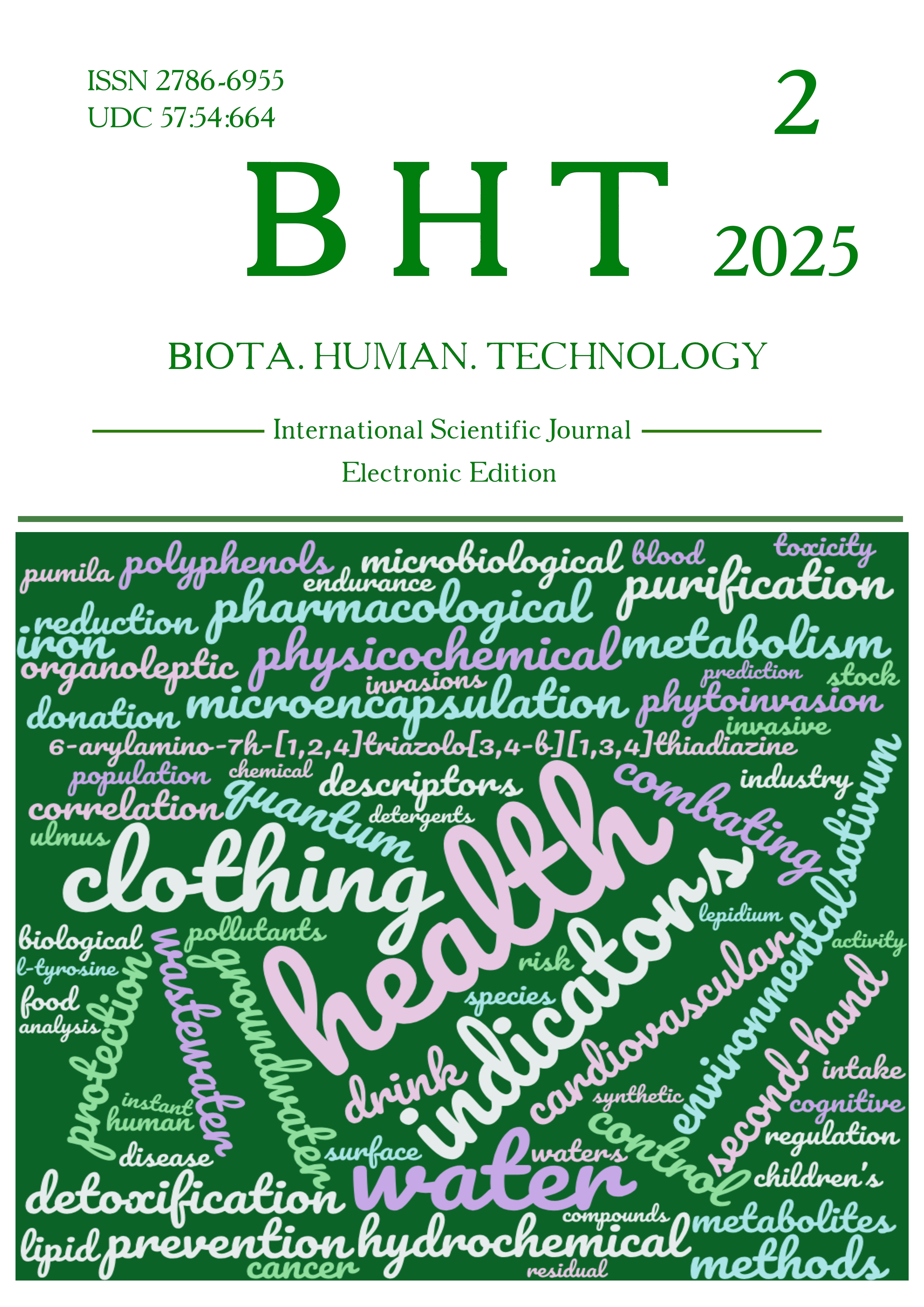CALCULATIONS OF THE SUITABILITY OF FOOD INDUSTRY WASTEWATER FOR BIOLOGICAL TREATMENT
DOI:
https://doi.org/10.58407/bht.2.25.5Keywords:
food industry, wastewater, environmental protection, biological purificationAbstract
Objective. Determination of pollution indicators of wastewater of various origins and calculations of their suitability for biological treatment of a certain type.
Methodology. The research was conducted by analyzing the level of pollution of wastewater of the III category of a sugar factory and the total effluent of a city dairy. Determination of pollution indicators of wastewater (COD, BOD, total nitrogen, phosphorus, etc.) was carried out in the ecological laboratory of the Department of Ecology and Ecomanagement of the National University of Food Technologies using standard methods. Laboratory installations were used to carry out the purification processes: aeration tank, methane tank, gasholder.
Scientific novelty. The study reveals the features of calculations regarding the suitability of wastewater of specific food industry enterprises for a certain method of biological treatment. The use of the calculations will ensure the selection of the optimal wastewater treatment technology, which will be economically and environmentally justified. This will optimize and accelerate the choice of the method of wastewater treatment.
Conclusions. The initial parameters of the III category wastewater of the sugar factory and the total wastewater of the city dairy were studied.
Calculations proved the suitability of the III category wastewater of the sugar factory for biological treatment under anaerobic conditions: with a ratio of BODtotal to COD equal to 0,76; with a COD indicator exceeding 2000 mg O/dm3; with a ratio of BODtotal to biogenic elements 464,7:7,12:1; with an optimal pH of 7,4 and the absence of toxic elements. The wastewater of the city dairy is suitable for aerobic biological treatment: with a ratio of BODtotal to COD equal to 0,81; with a COD indicator not exceeding 2000 mg O/dm3; with a ratio of BODtotal to biogenic elements 96,3:5,04:1; optimal pH 6,8 and the absence of toxic elements.
Methane fermentation of sugar factory wastewater resulted in high purification efficiency – 94,23 %. The amount of biogas was 0,923 dm3/g COD, the methane content in it – 66 %. Aerobic biological purification of dairy wastewater ensured purification efficiency – 96,88 %.
Downloads
References
Bublienko, N. (2021). Methane Fermentation of concentrated wastewater from sugar refineries. Food Industry, 29, 94–101. http://dspace.nuft.edu.ua/jspui/handle/123456789/36764 (in Ukrainian)
Бублієнко Н. О. Метанова ферментація концентрованих стічних вод цукрозаводів. Харчова промис-ловість. 2021. № 29. C. 94–101. http://dspace.nuft.edu.ua/jspui/handle/123456789/36764
Danchenko, Yu. M., Makarov, Е.О., Andronov, V.A., & Mirus, O.L. (2022). Improving the efficiency of electrocoagulation treatment of dairy wastewater by adding alkali. Bulletin of Lviv State University of Life Safety, 25, 19–27. https://journal.ldubgd.edu.ua/index.php/Visnuk/article/view/2317/2210 (in Ukrainian)
Данченко Ю.М., Макаров Є.О., Андронов В.А., Мірус О.Л. Підвищення ефективності електро¬коагуля-ційної очистки стічних вод молокозаводів шляхом додавання лугу. Вісник ЛДУБЖД. 2022. № 25. С. 19–27. https://journal.ldubgd.edu.ua/index.php/Visnuk/article/ view/2317/2210
Faraj, H., Jamrah, A., Al-Omari, S., & Al-Zghoul, Th. M. (2024). Optimization of an electrocoagulation-assisted adsorption treatment system for dairy wastewater. Case Studies in Chemical and Environmental Engineering, 9, 100574. https://doi.org/10.1016/j.cscee.2023. 100574
Golovko, M. P., Vlasenko, I. G., Golovko, T. M., & Semko, T. V. (2021). Technology of milk and dairy products with elements of HACCP: educational manual. Kharkiv. https://repo.btu.kharkov.ua/ bitstream/123456789/33891/1/NP_Tekhnolohiya%20moloka_NASSR_21.pdf (in Ukrainian)
Головко М. П., Власенко І.Г., Головко Т. М., Семко Т. В. Технологія молока та молочних продуктів з елементам НАССР: навчальний посібник. Харків: Світ Книг, 2021. 304 с. https://repo.btu. kharkov.ua/ bitstream/123456789/33891/1/NP_Tekhnolohiya%20moloka_NASSR_21.pdf
Joshiba, G. J., Kumar, S. P., Femina, C. C., Jayashree, E., Racchana, R., & Sivanesan, S. (2019). Critical review on biological treatment strategies of dairy wastewater. Desalination and Water Treatment, 160, 94–109. https://doi.org/10.5004/dwt.2019.24194
Kaur, N. (2021). Different treatment techniques of dairy wastewater. Groundwater for Sustainable Development, 14, 100640. https://doi.org/10.1016/j.gsd.2021.100640
Khomiuk, N., & Soltys, O. (2023). Food industry in Ukraine: trends and prospects for development on the basis of sustainability and inclusivesness. Sustainable Development of Economy, 1(46), 141–148. https://doi.org/10.32782/2308-1988/2023-46-20 (in Ukrainian)
Хомюк Н., Солтис О. Харчова промисловість в Україні: тенденції та перспективи розвитку на засадах сталості та інклюзивності. Сталий розвиток економіки. 2023. № 1(46). С. 141–148. https://doi.org/ 10.32782/2308-1988/2023-46-20
Motasem, Y. D. Al., Tharaa, M. Al., Salem, S. A. Am., & Madhusudhan, B. R. (2024). Microalgae cultivation for dairy wastewater treatment: insight from recent research and bibliometric analysis. Results in Engineering, 24, 103052. https://doi.org/10.1016/j.rineng.2024.103052
Patel, R. K., Shankar, R., Khare, P., & Mondal, Pr. (2022). Treatment of sugar processing industry wastewater using copper electrode by electrocoagulation: performance and economic study. J. of the Indian Chemical Society, 99, 100563. https://doi.org/10.1016/j.jics.2022.100563
Rodriguez-Sanchez, А., Gil-Pulido, В., Leonard, Р., Finnegan, W., Zhan, Х., Dobson, A. D. W., & O'Leary, N. (2024). Treatment of dairy wastewater using intermittent-aeration sequencing batch reactor at pilot-scale. Bioresource Technology Reports, 26, 101864. https://doi.org/ 10.1016/j.biteb.2024. 101864
Semenova, O. (2024). Environmental technologies and equipment: Laboratory Workshop. Kyiv. https://elibrary.nuft.edu.ua/library/DocDownloadForm?docid=412829 (in Ukrainian)
Семенова, О. Природоохоронні технології та обладнання: лабораторний практикум. Київ: НУХТ, 2024. 29. https://elibrary.nuft.edu.ua/library/DocDownloadForm?docid=412829
Stasinakis, A. S., Charalambous, Р., & Vyrides, І. (2022). Dairy wastewater management in EU: produced amounts, existing legislation, applied treatment processes and future challenges. J. of Environment al Management, 303, 114152. https://doi.org/10.1016/j.jenvman.2021.114152
Valente, G. de Fr. S., Mendonça, R. C. S., & Félix, L. B. (2020). Electrocoagulation using zinc electrodes for dairy industry wastewater treatment. Desalination and Water Treatment, 206, 58–65. https://doi.org/10.5004/dwt.2020.26294
Downloads
Published
How to Cite
Issue
Section
License
Copyright (c) 2025 Наталія Бублієнко, Оксана Салавор, Ольга Тогачинська, Оксана Ничик

This work is licensed under a Creative Commons Attribution 4.0 International License.


